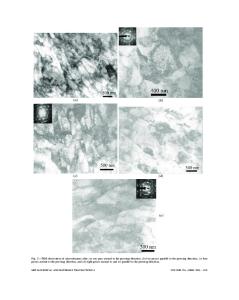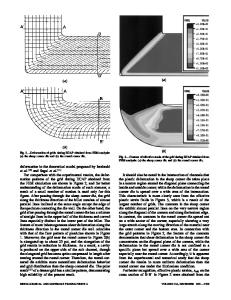Deformation Mechanism of Zr702 Processed by Equal Channel Angular Pressing
- PDF / 839,044 Bytes
- 10 Pages / 593.972 x 792 pts Page_size
- 46 Downloads / 305 Views
INTRODUCTION
EQUAL channel angular (ECA) pressing is a metal processing technique, whereby a severe plastic strain is imposed upon a polycrystalline specimen by extruding it through a special die.[1] This processing technique, when repeated several times, is capable of producing a microstructure with an ultra-fine grain (UFG) size,[2–8] which may lead to significant improvements in basic properties[9,10] of metals. The UFG microstructures have been obtained in various metal systems based on Al, Cu, Ni, Fe, Mg, and Zr.[11–24] Concerning the effects of the processing parameters on the microstructural evolution, the channel angles of dies and the deformation routes are considered to be important but not fully explored, particularly for the hcp metals.[21,22,25] Regarding the characteristics of the substructure development during heavy deformation such as cold rolling, the Risø group[26–33] proposed the concept of the cell block (CB) structure delineated by nearly parallel geometrically necessary boundaries (GNBs) in which cells were confined by incidental dislocation boundaries (IDBs). Accordingly, the grain refinement during the heavy plastic deformation was described as a gradual formation of GNBs and accumulation of the misorientation across them. This idea was successfully applied to the W.Q. CAO, formerly Postdoctoral Fellow, with the School of Materials Science and Engineering, Inha University, Nam-Gu, Incheon 402-751, Korea, is Research Fellow, Department of Materials Engineering, Monash University, Clayton, VIC 3800, Australia. S.H. YU, Graduate Student, Y.B. CHUN, Postdoctoral Fellow, and S.K. HWANG, Professor, are with the School of Materials Science and Engineering, Inha University, Nam-Gu, Incheon 402-751, Korea. Contact e-mail: [email protected] D.H. SHIN, Professor, is with the Department of Metallurgy and Materials Science, Hanyang University, Ansan, Kyunggi-Do 425-791, Korea. Manuscript submitted August 1, 2004. Article published online October 9, 2007. METALLURGICAL AND MATERIALS TRANSACTIONS A
cases of cold-rolled Al as well as ECA-pressed Al[25] but not sufficiently for the hcp metals. Unlike the fcc metals, the hcp metals undergo complex modes of deformation consisting of slip and twinning, which is sensitively affected by the purity of specimen, the amount of strain, the strain rate, and the temperature of deformation.[22] A combination of any specific process parameters may result in different microstructural development and thus different mechanical properties in the severely deformed metals. Therefore, it is essential to ascertain the basic mechanism of deformation during ECA pressing to gain unified understanding on the microstructural phenomena such as grain refinement. The present work was undertaken to answer the questions regarding the mechanisms of deformation and microstructural evolution of a severely deformed hcp metal, commercial purity Zr, Zr702. Particular attention was paid to the characteristics of the boundaries and texture developed during repeated ECA pressing, because these are related to
Data Loading...











